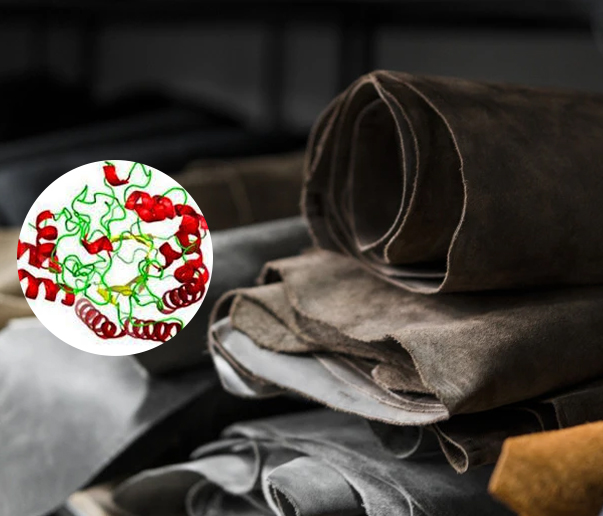
Leather Processing Enzymes
There has been tremendous growth in industries making increased use of biotechnology using processes such as biocatalysts and biotransformation. Enzymes in leather industry play a significant role to enhance the efficiency and sustainability of various stages to turn raw animals into fine-quality leather products.
Compared to traditional leather processing, the enzymes are environmentally friendly and minimize the need to use harsh chemicals in the making of leather products. The enzymes used in the leather industry can be used in several stages such as soaking, unhairing, bating, dyeing, and others.

Stages Involved In Leather Processing
Let’s take note of the various stages involved in the making of leather products and the way enzymes are used in each stage.
Soaking
The first stage in leather processing is soaking. The enzymes used in the soaking stage include amylolytic, lipolytic, and proteolytic enzymes. The use of enzymes reduces wrinkles in leather and improves the structure of the fibre. It brings about the best quality of leather as it removes all dirt, flesh, and blood.
Unhairing
As the name indicates, Unhairing means removing hair or fur from the skin. Compared to the conventional process of removing hair, the use of enzymes is much more environmentally friendly. Moreover, the enzymes also enhance the softness and area yield. Protease enzyme is used for un-hairing.
Fibre opening mechanism
The fibre-opening enzymes are meant to reduce the pollution load and the need for water treatment. This in turn makes the process economical. The enzymes used in fibre opening are Carbohydrases that open the fibre for water entry which in turn causes swelling.
Bating
The significant role of bating in enzymes is to loosen the skin structure by removing residues of inter-fibrillary proteins. The enzyme used in the bating process is the Proteolytic enzyme.
Degreasing
The enzyme used in degreasing is Lipases which degrades fat due to which, the leather cannot be damaged. The main benefit of using Lipase enzymes in degreasing is that it results in a uniform color and cleaner appearance.
Waste processing
Severe health hazards and environmental problems are caused by the discharges made by the leather industries. Fortunately, the use of enzymes hydrolyzed the solid waste. There is a constant temperature of 55 C as desired by the enzyme.
Stages Involved In Leather Processing
Many wonder if the use of enzymes is beneficial for the leather industry or not. Consequently, here are some notable benefits of using leather enzymes.
- The use of enzymes in the making of leather products reduces environmental impact and lowers pollution and waste levels.
- The leather quality is also improved and consistent with the use of enzymes. The leather products are now softer in their appearance.
- The overall energy consumption is also reduced by the use of enzymes as it requires lower temperatures and less energy.
Enzymes Used for Leather Processing
Leathozyme-PROAL (Protease for Soaking)
A leather soaking enzyme to be utilized in leather beam-house procedures is called Leathozyme-PROAL. It is made specifically for soaking skins and hides. For optimum rehydration, it selectively eliminates the intrafibrillary protein molecules that bind fibers. Additionally, it eliminates the connective tissue proteins, which helps to free the flesh and fat that has become embedded in skins. Albumin and mucin are two undesirable proteins that protease eliminates without harming collagen.
Leathozyme-PRO (Alkaline Protease for Dehairing)
Leathozyme-PRO is a multifunctional enzyme for unhairing skin and hides. To be employed in leather beam house procedures is alkaline protease, a leather unhairing enzyme. It successfully penetrates the hair bulb’s outermost sheath, improving depilation and producing flat leather free of creases and growth signs.
Leathozyme-LP (Lipase for Degreasing)
Leathozyme-LP is a combination of biodegradable chemicals and lipase enzyme for high-performance degreasing. Lipase enzyme used as degreaser to remove grease, oil, carbon, crayon or any other greasy soils from, utensils, food industry vessels, walls, floor, counter top, doors, metal components etc.
Texozyme-TP (Protease for Bating)
Texozyme-TP is used to bate pelts that need to be tanned but have been partially delimed or limed. It specifically removes the unwanted protein materials like elastin, albumin, mucoids and globulin, without damaging the collagen. It also eliminates coagulable inter-fibrillary protein, particularly elastin, as well as keratin-degraded byproducts such sebum glands and epithelial cells.
Are you looking for enzymes?
We're Here to Assist
Frequently Asked Questions(FAQ)
Enzymes revolutionize leather processing by enhancing softness, reducing environmental impact, and ensuring a more sustainable and efficient production process.
Yes, at Ultrez Enzymes, we specialize in tailoring enzyme solutions to meet the unique requirements of your leather processing, ensuring optimal results and performance.
Absolutely. Ultrez Enzymes is committed to eco-friendly solutions. Our enzymes for leather processing are designed to minimize environmental impact and promote sustainability.
Enzymes play a key role in breaking down undesirable components in hides, resulting in softer, more pliable leather. This leads to higher quality finished products with improved texture and appearance.
Ultrez Enzymes stands out for its commitment to innovation, quality, and sustainability. Our cutting-edge enzyme solutions are crafted to elevate the leather processing industry, providing unmatched performance and results.
